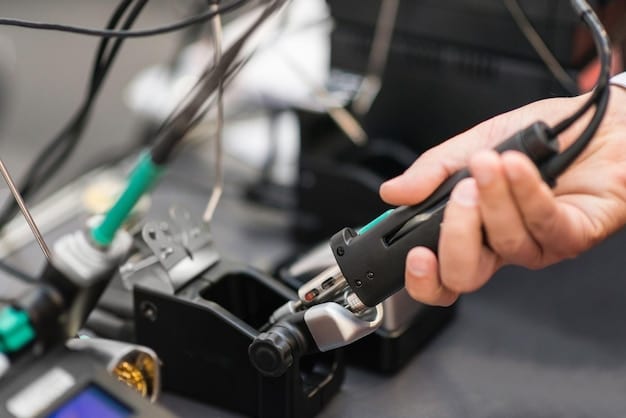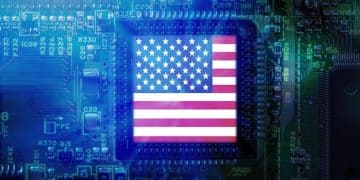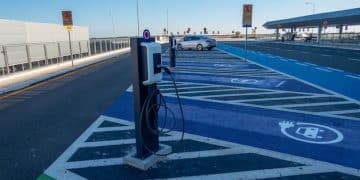Latest Battery Tech: Impact on US EV Range & Charging

Recent advancements in battery technology, such as solid-state batteries and improved lithium-ion variants, are significantly boosting electric vehicle range and influencing the development of faster and more widespread charging infrastructure across the US.
The electric vehicle (EV) landscape in the United States is rapidly evolving, and at the heart of this transformation lies battery technology. What are the Latest Developments in Battery Technology and Their Implications for Electric Vehicle Range and Charging Infrastructure in the US? Advancements in battery tech are not only extending the range of EVs but also accelerating the deployment of charging infrastructure, making electric mobility more accessible and practical for American consumers.
Advancements in Lithium-Ion Battery Technology
Lithium-ion batteries have been the cornerstone of EV technology for years, and ongoing improvements continue to enhance their performance. These advancements focus on increasing energy density, improving charging speeds, and enhancing battery lifespan, directly impacting EV range and usability.
Enhanced Energy Density
Researchers are constantly innovating to pack more energy into the same battery volume. This involves using new cathode and anode materials with higher energy storage capacities.
Faster Charging Capabilities
Reducing charging times remains a critical goal. Innovations in battery design and chemistry are enabling EVs to charge much faster, addressing a major concern for potential buyers.
Here are some key improvements driving lithium-ion battery technology:
- Silicon Anodes: Replacing traditional graphite anodes with silicon-based materials can significantly increase energy density.
- Nickel-Rich Cathodes: High-nickel cathodes offer greater energy storage capacity, extending the range of EVs.
- Improved Electrolytes: Advanced electrolytes enhance ion conductivity and stability, leading to faster charging and longer battery life.
These improvements in lithium-ion battery technology are pivotal in making EVs more competitive with gasoline-powered vehicles. By increasing range and reducing charging times, manufacturers can address two of the biggest barriers to EV adoption.

The Promise of Solid-State Batteries
Solid-state batteries represent a significant leap forward in battery technology. Unlike conventional lithium-ion batteries that use a liquid electrolyte, solid-state batteries employ a solid electrolyte, offering numerous advantages in terms of safety, energy density, and performance.
Increased Safety
The solid electrolyte is non-flammable, reducing the risk of fire and thermal runaway, a major safety concern with liquid electrolyte batteries.
Higher Energy Density
Solid-state batteries can potentially store more energy in a smaller volume, leading to longer driving ranges for EVs.
Solid-state batteries promise transformative improvements:
- Enhanced Stability: The solid electrolyte is more stable at higher temperatures, improving battery lifespan and performance.
- Faster Charging: Solid-state batteries can support faster charging rates due to improved ion conductivity.
- Reduced Size and Weight: The compact design can lead to lighter and more space-efficient battery packs.
While still in the developmental stage, solid-state batteries are poised to revolutionize the EV industry. Automakers and battery manufacturers are investing heavily in this technology, anticipating its potential to overcome the limitations of current lithium-ion batteries.
Advancements in Charging Infrastructure
The development of advanced battery technology goes hand in hand with the expansion and improvement of charging infrastructure. The availability of fast and reliable charging stations is crucial for supporting the growing number of EVs on US roads.
DC Fast Charging
DC fast chargers can add significant mileage to an EV in a short amount of time, making them essential for long-distance travel.
Wireless Charging
Wireless charging technology offers a convenient and user-friendly alternative to traditional plug-in charging.

Key developments in charging infrastructure include:
- Increased Power Levels: Ultra-fast chargers with power levels of 350kW and higher are being deployed, significantly reducing charging times.
- Wider Network Coverage: Expanding the network of charging stations, particularly in rural areas and along major highways, is crucial for addressing range anxiety.
- Smart Charging Solutions: Integrating charging stations with the grid and using smart charging algorithms can optimize energy usage and reduce costs.
The expansion of charging infrastructure is vital for supporting the widespread adoption of EVs. A robust and accessible charging network will alleviate concerns about range and charging availability, encouraging more consumers to make the switch to electric vehicles.
Impact on Electric Vehicle Range
The advancements in battery technology directly translate to increased EV range. Longer ranges make EVs more practical for daily commutes and long-distance travel, enhancing their appeal to a broader audience.
Extended Driving Distances
New battery chemistries and designs are enabling EVs to travel further on a single charge, reducing the need for frequent stops.
Improved Energy Efficiency
Advanced battery management systems and thermal management techniques are optimizing energy usage, further extending range.
The impact on EV range is evident in several key areas:
- Reduced Range Anxiety: Longer ranges alleviate concerns about running out of power, making EVs more suitable for various driving needs.
- Enhanced Usability: Increased range makes EVs more practical for daily commutes, road trips, and other driving scenarios.
- Competitive Advantage: EVs with longer ranges are more competitive with gasoline-powered vehicles, attracting a wider range of consumers.
The continuous improvements in battery technology are driving significant increases in EV range, making electric vehicles a viable option for a growing number of drivers.
Challenges and Opportunities
Despite the significant progress in battery technology and charging infrastructure, several challenges remain. Addressing these challenges is crucial for realizing the full potential of electric vehicles.
Raw Material Sourcing
The increasing demand for battery materials such as lithium, nickel, and cobalt raises concerns about supply chain sustainability and ethical sourcing.
Battery Recycling
Developing efficient and cost-effective battery recycling processes is essential for minimizing environmental impact and recovering valuable materials.
Opportunities for further advancement include:
- Developing Sustainable Supply Chains: Investing in responsible mining practices and exploring alternative battery materials can mitigate supply chain risks.
- Improving Recycling Technologies: Advancing battery recycling technologies can recover valuable materials and reduce waste.
- Reducing Battery Costs: Continued innovation in battery technology can drive down costs, making EVs more affordable for consumers.
Overcoming these challenges and capitalizing on emerging opportunities will pave the way for a sustainable and widespread adoption of electric vehicles in the United States.
Government and Industry Initiatives
Government policies and industry collaborations play a crucial role in driving the development and deployment of advanced battery technology and charging infrastructure. These initiatives provide funding, incentives, and regulatory frameworks to support innovation and adoption.
Federal Funding and Incentives
Government programs such as tax credits and grants support research and development, manufacturing, and deployment of EV technologies.
Industry Partnerships
Collaboration between automakers, battery manufacturers, and technology companies accelerates innovation and promotes standardization.
Key initiatives driving progress include:
- The Bipartisan Infrastructure Law: This law provides significant funding for EV charging infrastructure and battery research and development.
- The Inflation Reduction Act: This act offers tax credits for EV purchases and battery manufacturing, incentivizing domestic production.
- Industry Consortia: Organizations like the United States Advanced Battery Consortium (USABC) foster collaboration and knowledge sharing among industry stakeholders.
Government and industry initiatives are essential for creating a supportive ecosystem for the growth of the electric vehicle market. By providing funding, incentives, and regulatory frameworks, these initiatives are driving innovation and accelerating the adoption of EVs in the United States.
| Key Point | Brief Description |
|---|---|
| ⚡️ Lithium-Ion Advancements | Enhanced energy density and faster charging are improving EV performance. |
| 🔋 Solid-State Batteries | Promise increased safety and higher energy density for longer EV ranges. |
| 🔌 Charging Infrastructure | Expanding DC fast charging and wireless options are crucial for EV adoption. |
| 💰 Government Initiatives | Federal funding and industry partnerships are driving EV technology forward. |
Frequently Asked Questions (FAQ)
▼
Key advancements include silicon anodes for higher energy density, nickel-rich cathodes for greater capacity, and improved electrolytes for faster charging and enhanced stability, all leading to better EV performance.
▼
Solid-state batteries use a non-flammable solid electrolyte, which reduces the risk of fire and thermal runaway compared to the liquid electrolytes used in traditional lithium-ion batteries, making them much safer.
▼
Challenges include the high costs of installing and maintaining charging stations, ensuring equitable access in rural and underserved areas, and upgrading the grid to handle increased electricity demand from EV charging.
▼
Government funding supports EV battery technology through grants for research and development, tax credits for manufacturing and purchasing EVs, and investments in charging infrastructure, all aimed at accelerating EV adoption.
▼
Battery advancements that increase energy density and improve efficiency directly extend EV range, thereby reducing range anxiety. This makes EVs more practical and appealing for daily commutes and long-distance travel.
Conclusion
The latest developments in battery technology are significantly shaping the future of electric vehicles in the US. Advancements in lithium-ion and the emergence of solid-state batteries, coupled with the expansion of charging infrastructure, are driving longer ranges, faster charging times, and increased accessibility, making EVs a more compelling option for American consumers. While challenges remain, ongoing government and industry initiatives are paving the way for a sustainable and electric transportation future.





